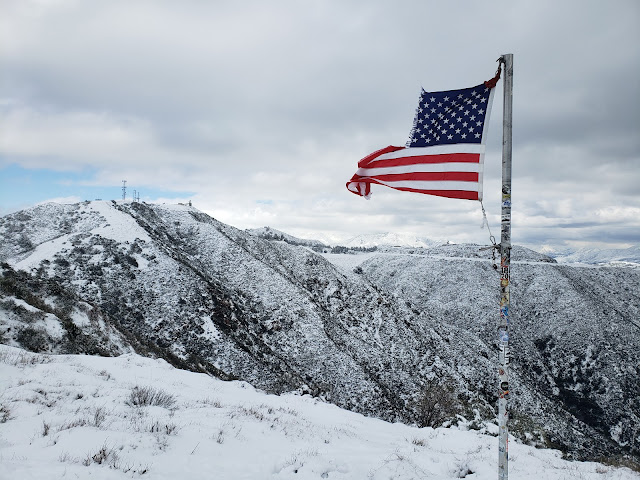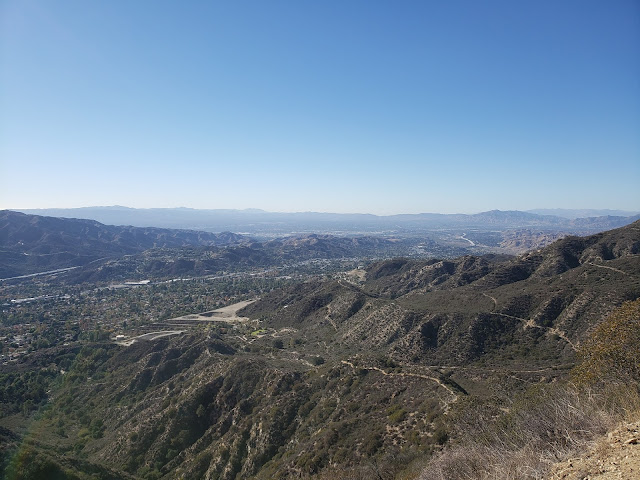Excerpt from The True Way by Lizzie Miller (p. 213)
Lizzie E. Miller was a 19th century evangelist who traversed the country sharing the good word with anyone who would listen to it. In 1889, her travels brought her to Southern California where she had occasion to visit historic Switzer’s Camp in the San Gabriel Mountains and proselytize to patrons of that wooded establishment. Lizzie’s course to Switzer took her up the Arroyo Seco from Pasadena, over Burnt Peak, across the “Backbone,” around the foot of Mt. Washburn with its view of dramatic Rose Peak, and then down into the upper stretches of the shaded Arroyo. Her route to Switzer’s and her evangelizing sojourn are memorialized in a book that she self-published in 1895 titled “The True Way.”
Despite some confusing narrative about the location of Burnt Peak, my friend and fellow adventurer Sean “Cucamonga Man” Green was convinced that Peak 3,221, a point that sits just south of Mt. Washburn sandwiched between Long Canyon and the Arroyo Seco, was Lizzie’s Burnt Peak. So early on New Year’s Day, we, joined by our compatriot JeffH, set out for Peak 3,221 to see if we could confirm Sean’s suspicions. Expecting to encounter a sea of unruly manzanita and buckthorn, we came prepared for battle armed with loppers, clippers, silky saws, and booze.
We started the day at the popular Lower Switzer parking area which was comfortably empty when we arrived. The hung-over hordes of celebrants from the previous night would arrive later in the morning when the sun finally broke through, snapping up the remaining spots and generally creating a traffic snafu. But for the time being it was quiet and we had the cool canyon bottom to ourselves as we rock-hopped back-and-forth across the Arroyo which held decent flow for this time of year. At the site of Commodore Switzer’s celebrated camp which sits at the precipice of the upper falls, we stopped briefly to admire and test a finely constructed outdoor sofa and coffee table that some creative soul had assembled from fallen tree branches.
From here, we climbed out of the canyon and onto the east flank for Mt. Washburn, following the well-worn and defined Gabrieleno Trail to its junction with 12W08 which dips back into the Arroyo and continues up Bear Canyon. We stayed high and continued along the Gabrieleno which affords sublime looks into Bear Canyon, neighboring Little Bear Canyon, and the rugged recesses of the Royal Gorge. Identifiable peaks abound from this stretch of trail including Rose Peak, Mt. Markham, Mt. Lowe, and Brown Mountain (named for notorious abolitionist John Brown).
A short distance later we arrived at the southern toe of Mt. Washburn. Here, the Gabrieleno doubles back in a north-westerly direction as it drops into adjacent Long Canyon. Wahsburn’s ridgeline continues in a southwesterly orientation across the trail, over a bump, and then out to what we surmised was Burnt Peak. We stopped briefly to retrieve machetes and other tools and to put on armor in preparation for the anticipated brush battle ahead. Then we dove into the head-high chaparral, loppers at the ready. But about ten yards in, we were surprised to discover that a path had already been carved through the dense brush all the way to our objective. So we happily sheathed our tools and ambled easily along the ridgeline that Lizzie called the “backbone” until we reached the top of the first bump where the track suddenly petered out. Something wasn’t right. We could see the path continuing all the way to Burnt Peak below us, but the terrain was crumbly and steep on all sides and there didn’t seem to be an obvious way to connect where we were to where we wanted to be. Going directly over the front lip looked like the least dangerous option so that is the option we took, slipping and sliding and cutting and trimming unruly Sumac and Chamis as we went. After a brief yet exhilarating down-climb, we arrived at a shallow saddle where we were able to rejoin the existing use path.
From this point, it was a relatively short jaunt to the summit. The path held, but was slightly overgrown in places so we manicured as we went. Along the way we found some old wires, cables, and an anchor suggesting that at one time telephone poles may have run along the ridgeline. Atop Burnt, there was a clearing of sorts with two different rock piles. There was no register and no discernable benchmark. We identified the slightly higher of two rock piles and then cleared the area to make it more accommodating. That’s when the booze came out. It was a New Years hike after all. I had carried a bottle of Pennsylvania Dutch Eggnog in my pack and Sean brought individual cans of Screwball, a dangerous cocktail of peanut butter flavored whiskey.
Containers open, we sat in the shade getting “tight” as Ernest Hemingway or F. Scott Fitzgerald might say, shooting the shit, and trying to imagine what this place was like back in Lizzie Miller’s time. Ironically, the area may be more remote now than it was back in Lizzie’s day when the route to Switzer’s from Devil’s Gate apparently traversed this ridgeline.
Eventually the ethanol ran dry and the three of us, now slightly inebriated, started our way back. When we arrived at the low saddle between Burnt Peak and the first bump, we discovered that the use path that we followed in actually circumvented the hillock to the west. So we stayed the course of lesser resistance which ultimately deposited us just north of the bump’s top. The “junction” here was over-grown and not immediately evident which explains how we missed it on the way in. To prevent that mistake by others, we trimmed the “entrance” to make it more discernable, at least until the fast-growing chaparral conceals it from view once again.
Back at the Gabrieleno’s junction with 12W08, Sean and Jeff dropped into the Arroyo to see the falls. Having done that a couple of times previously, I continued back to the original Switzer’s camp location and climbed to the promontory above the gorge where the chapel once stood. Religious fervor is a powerful motivator and the planning, labor, and tenacity it must have taken to construct the chapel is quite impressive to think about, particularly given the mechanical and technological limitations of the time. Not much remains of the original structure which was destroyed by the Forest Service in 1943 because it was deemed unsafe. I was able to find some of the foundation and floor, but none of the arch remnants that have probably been swallowed up by brush and time.
About an hour later I reconnected with Sean and Jeff and we walked out. On the way, a B-2 Stealth Bomber flew overhead on its way to or back from a fly-over of the Rose Parade. It was apropos as there was also a parade of sort happening along the Gabrieleno as throngs of people and dogs now clambered and clamored down the draw. A short distance from the picnic area, a natural spring emerges from a pipe at the base of a rocky embankment and flows across the trail. A nearby Forest Service sign warns “Water Unsafe For Drinking.” Not one to be told what to do by faceless, government functionaries, Jeff retrieved a water bottle from the depths of his pack, defiantly filled it to the brim, and then took a deep, long pull as passer-bys eyed him with bemusement. Jeff is a seasoned backpacker who has sampled unfiltered water many times over years of tramping the trails, so I’m certain that he was fine. At the same time, I have neither seen nor heard from him since so who knows? But if he is now no longer with us, at least he proudly left with his middle finger stuck high in the air. Lizzie Miller would probably not approve. But it is the true way to go out.


















































